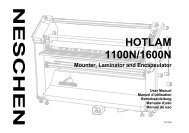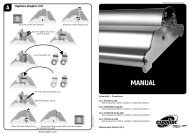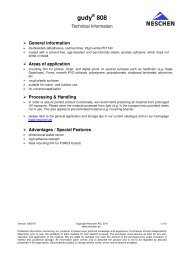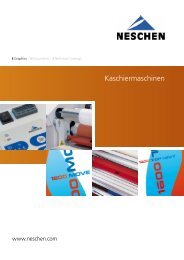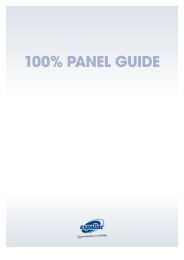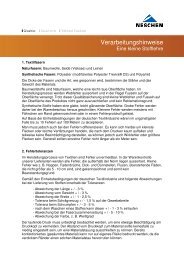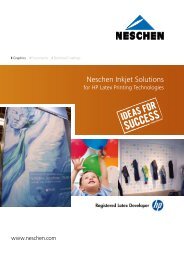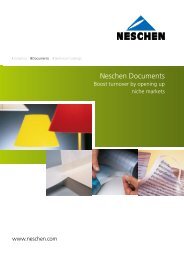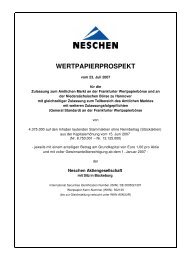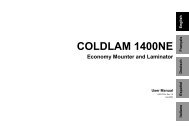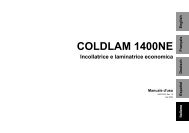Annual Report 2005
Annual Report 2005
Annual Report 2005
Create successful ePaper yourself
Turn your PDF publications into a flip-book with our unique Google optimized e-Paper software.
Notes relating to the consolidated annual accounts<br />
Liabilities<br />
Financial obligations from financing leases are shown as liabilities at the current value of the future lease payments.<br />
Liabilities due to banks are shown at the amount payable received minus directly attributable expenditure. Financing costs including those connected with the<br />
repayment or discharge of premiums payable are shown on an accruals basis and will increase the book value of the instrument unless they were paid when it<br />
was created.<br />
Liabilities from supplies and services as well as other liabilities are shown at their repayment value apart from derivative financial instruments which are shown<br />
at fair value in accordance with IAS 39 “Financial instruments: recognition and measurement”.<br />
Contingencies<br />
Contingencies are possible or existing liabilities based on past events where an outflow of resources is, however, regarded as improbable. In accordance with IAS<br />
37 “Provisions, contingent liabilities and contingent assets”, such liabilities are not to be entered in the balance sheet but specified in the Notes to the balance<br />
sheet.<br />
Recognition of derivative financial instruments/Hedge accounting<br />
All derivative financial instruments are to be recognised at fair value in accordance with IAS 39 “Financial instruments: recognition and measurement”.<br />
The valuation of derivative financial instruments is based on inter-bank conditions or rates of exchange, using the buying and selling rates on the closing date. If<br />
exchange rates are not used, the fair value will be calculated using recognised financial models. The fair value shown corresponds to the amount for which an<br />
asset could be exchanged or a liability settled between knowledgeable, willing business partners in an arm’s length transaction in each case.<br />
Profits and losses resulting from derivative financial instruments which have been defined as qualified hedging tools within a fair value hedge or for which it was<br />
not possible to create a qualified hedge in accordance with IAS 39 “Financial instruments: recognition and measurement” and therefore hedge accounting cannot<br />
be carried out will be shown as affecting the result in the profit and loss account. The results from derivative financial instruments for which a cash flow hedge<br />
is created and which are proven to be effective will be shown in the shareholders’ equity capital without affecting the result until the time when the secured<br />
underlying transaction is realised. The effects of any changes to the result caused by the ineffectiveness of these financial instruments will be shown immediately<br />
in the profit and loss account.<br />
Share-based payment systems<br />
The Group is not currently operating any share price-oriented payment systems via shareholders’ equity capital instruments or share price-oriented cash payment<br />
systems.<br />
The making of assumptions and use of estimates<br />
When the Group’s financial statement was drawn up, assumptions were made and estimates used which affected the presentation and levels of assets, liabilities,<br />
income, expenditure and contingencies shown. These assumptions and estimates mainly related to the standardised determination of useful commercial lives within<br />
the Group, the valuation of provisions and the feasibility of future tax relief. In individual cases, the actual values may differ from the assumptions made and<br />
estimates used. Changes will be taken into account and shown as affecting the result when further information on these becomes available.<br />
Realisation of profit<br />
Income will be valued at the current value of the consideration received or debt to be reconciled and represents amounts for goods supplied and services provided<br />
as part of normal business activity minus discounts, turnover tax and other taxes arising in connection with sales.<br />
Proceeds from the sale of goods will be entered on delivery after the transfer of ownership.<br />
Income from interest will be determined for periods taking into account the outstanding amount of the loan and the effective interest rate to be applied. The effective<br />
interest rate is the interest rate to be used in order to ensure that the current value of the payments expected to be made in the future over the expected useful<br />
life of the financial asset is equal to the net book value.<br />
Dividend income from financial investments will be entered when the shareholder becomes entitled to payment.<br />
Research and development costs<br />
It is not permitted to show research costs as assets. Development costs are to be shown as assets if cumulatively all the appropriation criteria from IAS 38<br />
“Intangible assets” are met, the research phase can be clearly distinguished from the development phase and costs incurred can be attributed to the individual<br />
project phases without any overlapping.<br />
57




